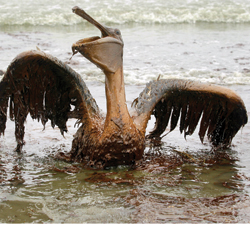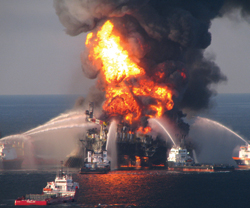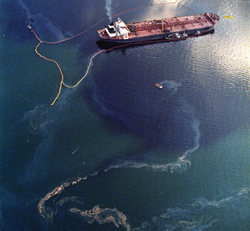The Price of Oil

OnEarth.org
Note: This month’s CLE, “The Price of Oil,” is Wednesday, Aug. 18.
The legal repercussions from the BP oil spill in the Gulf of Mexico are spreading quickly. But like so many other aspects of the catastrophe, it is hard to predict where the legal battles will lead—and impossible to say when, or how, they will end.
By the end of June, with the closure of vast stretches of federal fishing waters, and with tourism plummeting along the U.S. Gulf Coast, emergency claim centers established by BP already had been flooded with some 87,000 requests for compensation to keep mortgages paid, businesses afloat and families fed.
And those may be just the leading edge of the claims that will come in as the well blowout 5,000 feet below the surface of the Gulf continues to spew oil with sickening regularity despite all efforts so far to stop it. When this story went to press in early July, there had been no successful attempts to limit the flow of oil.
The importance of getting money in a timely fashion to people hurt by the spill is widely acknowledged. “For the small-business owners, for the fishermen, for the shrimpers, this is not just a matter of dollars and cents,” said President Barack Obama in a statement issued in mid-June during talks with BP officials. “A lot of these folks don’t have a cushion.”
No one wants to see a replay of the two-decades-long litigation that followed the 1989 Exxon Valdez oil spill in Alaska’s Prince William Sound, which was notorious for being the worst oil spill in U.S. waters—until BP’s Deepwater Horizon rig exploded April 20 some 40 miles off the Louisiana coast.
That’s why the agreement hashed out in June between Obama and BP Chairman Carl-Henric Svanberg to create a $20 billion compensation fund for Gulf spill victims was hailed as a way to bypass potential legal logjams and distribute funds quickly and efficiently. BP agreed to add additional money to the fund if compensation costs exceed $20 billion.
The fund also can be used to pay other judgments and settlements, cover state and local cleanup costs, and help salvage threatened natural resources.
The Gulf Coast Oil Spill Claims Facility will be administered by attorney Kenneth R. Feinberg of Washington, D.C., founder and managing partner of the mediation firm Feinberg Rozen. Feinberg has been involved in a number of notable claim settlements in recent years, including being appointed as administrator of the $7 billion Sept. 11 Victim Compensation Fund. (See “The Go-To Mediator.”)
Feinberg is empowered to decide what standards to apply in disbursing money from the fund to claim ants. “I may use applicable state law or maritime law or other government law in order to leave open the possibility of applying a third standard,” he said during an interview with the ABA Journal on June 26. Those comments appeared to back away from earlier statements suggesting that he might rely primarily on the law of each claimant’s home state to guide his compensation decisions.

Win McNamee/Getty Images
‘A CLEAN SLATE’
The BP compensation fund is causing growing debate among lawyers and other experts in maritime law and compensation systems. It may be too early to tell how efficient the fund will really be or whether it will be an improvement on laws passed in the wake of the Alaska spill to address compensation issues.
“We’re early in the game with the new fund,” says Zygmunt J.B. Plater, a professor at Boston College Law School in Newton who chaired the Alaska Oil Spill Commission’s legal task force during a two-year period after the Valdez spill. “My point is that it’s a game changer. This whole blowout is a game changer, and the agreement that Obama made with Svanberg is unprecedented.” In terms of how claims will be handled, Plater says, “we’re writing on a clean slate.”
But not everyone is applauding the fund. “My belief is that it has been set up to save BP money by forcing claimants to make an upfront election of lump-sum payment in return for a full and final release of all claims against BP,” says Rhon E. Jones, who manages the toxic torts section at Beasley, Allen, Crow, Methvin, Portis & Miles in Mont gom ery, Ala. But a final assessment of whether claimants should seek settlements under the fund or litigate their cases should wait until all the fund’s rules and procedures are in place, says Jones, who co-chairs the Gulf Oil Spill Litigation Group for the American Association for Justice.
Technically, the well blowout in the Gulf of Mexico is different from what occurred 21 years ago when the Exxon Valdez (PDF) hit the Bligh Reef off the Alaska coast. That was a classic oil spill in which the broken ship released some 11 million gallons of oil into Alaskan waters.
That distinction aside, the end result is the same: Oil choking a body of water that was vibrant with wildlife and the source of the livelihoods of thousands of people.
But there is one other difference: The BP spill is so gigantic that according to some reliable estimates it has been leaking the equivalent of one Exxon Valdez oil spill into the Gulf of Mexico every four days for more than two months, and it will continue doing so unless relief pipelines being drilled by BP can siphon off the oil flowing out of the broken underwater well. The company hopes that work will be completed later in the summer.
The Exxon spill coated 1,300 miles of the Alaskan coastline with oil; it killed hundreds of thousands of seabirds and animals, as well as billions of fish eggs. Despite a $2.1 billion cleanup effort by Exxon, some of this oil still lingers. “If you pick up a rock on many of Alaska’s rocky beaches, you can still see oil percolating up,” Plater says.
In the wake of the spill, lawsuits were filed in both state and federal courts. Eventually, the bulk of the claims were consolidated and tried in federal court under a maritime negligence tort.
In 1994, a jury awarded the plaintiffs $287 million in compensation and $5 billion in punitive damages. Exxon appealed, and the case dragged on until two years ago. On June 25, 2008, the U.S. Supreme Court issued a controversial ruling in Exxon Shipping Co. v. Baker (PDF) that, in maritime torts, punitive damages should be awarded on a dollar-for-dollar basis with compensatory damages. Since Exxon had paid out a total of $507 million in compensation in various settlements, under Baker its punitive damages were limited to the same amount. Thousands of plaintiffs didn’t settle their last issues with Exxon until April—the same month the BP rig blew in the Gulf of Mexico.

AP Images
THE LEGAL CAP
In 1990, Congress passed the Oil Pollution Act, which brought some fundamental changes to the law governing oil spills. One of the act’s key provisions requires parties responsible for oil spills to cover all cleanup costs. The act also permits economic damages resulting from a spill to be recovered from a responsible party. At the same time, however, the act caps a responsible party’s liability for economic and other damages at $75 million, and does not provide for recovery of punitive damages.
The $75 million cap does not apply if the spill was caused by “gross negligence or willful mis conduct,” or if the responsible party or any of its agents violated a federal safety regulation. The act also established the Oil Spill Liability Trust Fund, funded primarily through a five-cent-per-barrel tax on the oil industry, to help cover removal costs and damages when a responsible party is unable or unwilling to make appropriate payments.
The Oil Pollution Act is “just one big screw job for claimants,” says Brian B. O’Neill, a partner at Faegre & Benson in Minneapolis who represented 32,000 fishermen and Alaska natives in litigation against Exxon.
And although OPA preserves state law remedies for oil spills, both the 1st U.S. Circuit Court of Appeals at Boston and the 9th Circuit at San Francisco have ruled that the act pre-empts the maritime negligence cause of action under which Exxon was tried.
“Under a maritime cause of action, if you prove negligence you’re entitled to your damages, including punitive damages, with no cap,” says O’Neill. “A plaintiff was better off in 1989 than he is today.”
A SPILL TOO FAR
But others maintain that OPA is a significant improvement over the remedies that were available under maritime law when the Valdez ran aground in 1989.
If not for the Oil Pollution Act, the BP oil spill would be governed by traditional maritime law because it occurred in open waters, says Martin J. Davies, director of the Tulane Maritime Law Center at Tulane University Law School in New Orleans. That means it also would fall under the 1927 ruling in Robins Dry Dock & Repair Co. v. Flint, in which the Supreme Court held that a plaintiff alleging a maritime tort must have suffered a direct physical injury to be eligible for compensation. The opinion written by Justice Oliver Wendell Holmes has been widely interpreted as a bar to compensation for purely economic losses under maritime law. (There is an exception for commercial fishermen.)
A key question is whether OPA’s legal regime is adequate to deal with the scope of the BP oil spill. Some experts have their doubts.
“We really don’t have an analogous situation” to the Gulf spill, says Mark Davis, director of the Tulane Institute on Water Resources Law and Policy and a senior research fellow at the law school. “Damages are three-dimensional and extend for thousands of square miles, and they continue to happen every day. This is not what OPA envisioned.”
Davies expresses similar concerns, even though BP has said it will pay all “legitimate” claims over and above the $75 million cap set by the Oil Pollution Act.
OPA may not provide much guidance if it is used as a precedent for determining legitimate claims, largely because it is silent on the question of whether individuals and businesses who suffer indirect losses from the spill would be able to claim compensation. Such claimants might include an oyster restaurant that must now import oysters, or a travel agent who has seen her bookings sink as oil befouls the beaches.
OPA “doesn’t say ‘proximately caused by,’ ” Davies says. “It says ‘due to.’ ” And due to, he says, “is a slippery phrase. The big question will be: How far away will the line be drawn by the courts?”
Or by Feinberg. Boston College’s Plater thinks the administrator of the claims facility has a chance to make new law that could have a particularly important impact on how states in the region deal with such claims.

Until this April, the worst oil spill in U.S. waters was the April 1989 Exxon Valdez disaster, which coated 1,300 miles of Alaskan coastline. AP Images
Lawyers and others parsed Feinberg’s early comments about applying state law standards to claims because many of them impose tight restrictions on claims.
“In Louisiana, one of the limitations of state law is a $75 million cap on damages, and a lot of other states have rules akin to Robins Dry Dock” that bar recovery for economic losses, O’Neill says. “Florida courts have only recently allowed fishermen to collect in oil spills.”
O’Neill also worries about the releases claimants will be required to sign—and how quickly—if they settle claims through the Gulf Coast fund. “He’s said that he wants to tie this thing up in four years,” O’Neill says. “But the manifestations of this spill may not be seen in four years.”
CLAIMANT’S CALL
Feinberg says that while the oil is still leaking, claimants may collect emergency payments for immediate needs without waiving the right to sue BP in the future.

After BP’s Deepwater Horizon rig exploded, a drill ship collected oil near the Louisiana coast. Saul Loeb/AFP Getty Images
Once the oil stops leaking and full damages can be assessed, a lump sum will be offered to claimants, according to Feinberg. If a claimant accepts the lump sum, he or she will be required to sign a waiver promising not to sue BP in the future.
The temptation for claimants to accept a final settlement before they know the full extent of their losses “is a very real concern,” Feinberg told the ABA Journal, “and I want to make sure that when a lump sum is offered that the client fully does understand the nature of the release and the inability to go to court, and that there is full disclosure and transparency.”
But, Feinberg says, “it’s entirely up to the claimant to accept the lump sum.” And claimants who reject a settlement through the fund will be free to sue under OPA, maritime tort law, or any other applicable state or federal laws.
At the same time, however, Feinberg says the fund will not operate under an assumption that claimants should be represented by counsel. “The goal of this program is to minimize the legal technicalities and maximize efficient, swift payment,” he says.
And Feinberg affirmed his intention to have the fund wrap up its work relatively quickly, even if the full damages from the spill have yet to be determined. The key, he says, is to offer a lump-sum settlement that is adequate to allow a claimant to “move on, while at the same time avoiding the possibility of additional litigation that in the end could be protracted, uncertain and costly.”
Even if this means that some claimants might be undercompensated?
“It may be undercompensation or it may be overcompensation,” Feinberg says. “It’s a very murky crystal ball. What’s important is that it is adequate to end the uncertainty and bring the matter to a close.”
Editor’s Note
After a 14-year run, this is the final installment of our monthly ABA Connection series, which paired a feature story about a substantive area of the law with a continuing legal education course. We will, of course, continue to cover developments in a variety of practice areas, but without links to a specific CLE program.
ABA Connection began in 1996 and was one of the first CLE courses provided by teleconference. Today, teleconferences are the norm for CLE providers; the ABA itself offered more than 350 in the last year.
So we’re returning to our innovative roots. Starting next month, the ABA will offer a new form of CLE to sole practitioners—the largest group of registrants for the ABA Connection series. Sept. 28-30, our online Smart Soloing School will be in session, offering solos in private practice up to 18 CLE credit hours for free. The programs will remain online for the following 12 months for those who can’t attend the live event. You can learn more about our Smart Soloing School at ABAnet.org/cle/smartsoloing.
ABA Connection offers three easy ways to get low cost/no cost CLE credit
Live Call-in Teleconferences
This month’s CLE, “The Price of Oil,” is Wednesday, Aug. 18.
To register, call 1-800-285-2221 between 8:30 a.m. and 6:30 p.m. (ET) weekdays starting July 26, or go to abanet.org/cle/connection.html. Multiple participants may listen via speakerphone, but each individual who wants CLE credit must register separately.
Co-Sponsors: Criminal Justice Section; Dispute Resolution Section; General Practice, Solo & Small Firm Division; Judicial Division; Law Practice Management Section; Section of Administrative Law and Regulatory Practice; Section of Environment, Energy and Resources; Section of Public Utility, Communications & Transportation Law; Section of Science and Technology Law; Section of State and Local Government Law; Tort Trial & Insurance Practice Section.
Online Access—At No Cost
Online Streaming Audio, available starting Aug. 23. To register, go to abanet.org/cle/connection.html. Past programs are available here.
CLE on Podcast
Podcast downloads are available starting Aug. 23.
Last updated July 22 to note that this magazine article went to press in early July.
Kristin Choo is a freelance writer in New York City.



